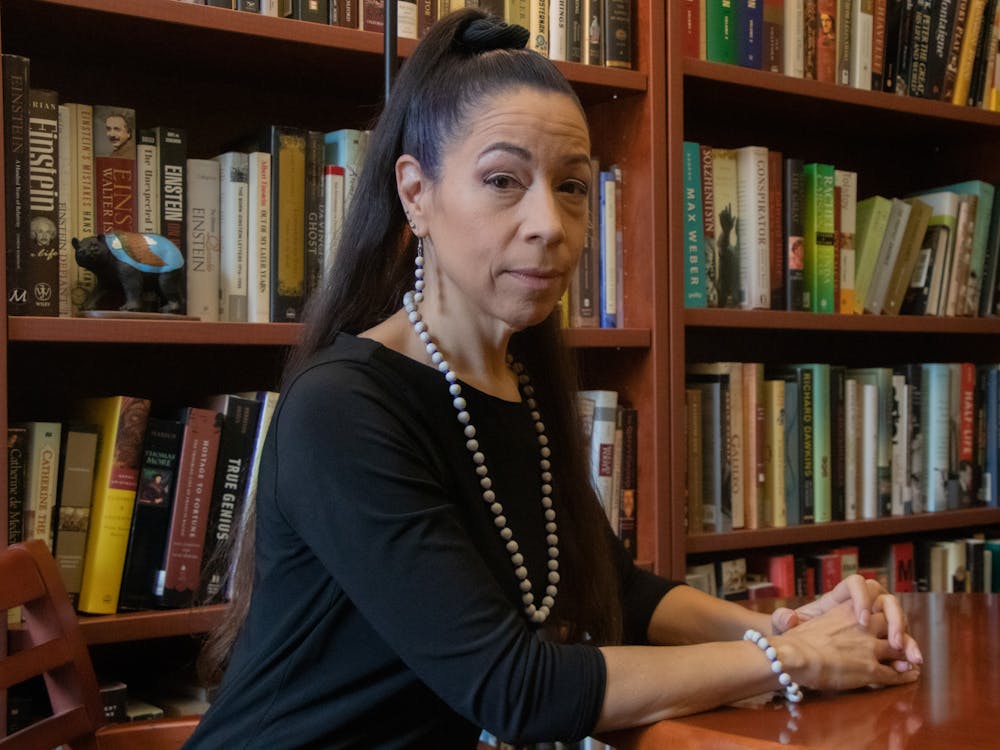Although CULANTH102: American Indian Nations Today doesn’t start until 12 p.m., nearly every student is waiting in their seat 10 minutes earlier on this October afternoon. Then Dr. Courtney Lewis promptly strides into the room.
Her dark hair is pulled into a high ponytail, revealing tiny square woodcuts of the Cherokee water spider dangling from her earlobes.
“They’re burned in wood because Cherokee legend has it that the water spider brought fire to the Cherokee people,” she tells the class.
This semester, the Trinity College of Arts and Sciences welcomed Lewis to the cultural anthropology department as associate professor and Trinity’s first American Indian professor. Lewis' hiring was part of Trinity's cluster hire in Native American and Indigenous Studies in spring 2021. With previous experience teaching Native American studies at the University of South Carolina, Davidson College and Wesleyan University, Lewis was well equipped for the position.
“Building cohesive structures for Native American studies is so important,” Lewis said. “There is a lot of racism against American Indians in academia, and it’s important that people are made aware of this narrative.”
Lewis, a Cherokee citizen, described the marginalization and stereotypes from professors and students she faced growing up. The American school system historically sidelines Native American figures in history and misrepresents American Indian culture, she said.
“You’re being disappeared as you’re being taught,” Lewis said. “You’re being fed the Thanksgiving story in elementary school, and you’re the only one who knows that it’s wrong.”
Her father, Ronald G. Lewis, was the first American Indian to receive a doctorate in social work in 1974. Forbidden from speaking Cherokee in public schools, both father and daughter came back to the language together later in life. The single sticker on the back of her laptop is a thumbs up that reads “Osda” — “Good” in Cherokee.
Lewis begins every class period with a brief review of recent news articles about Native Nations across the country. In a course that she dubbed “American Indians 101,” Lewis works to introduce Duke students to the diversity of modern American Indian Nations in the United States. This October class period started with a discussion over Cherokee Nation and Chippewa blood quantum systems.
“I hope that the students learn something new, unexpected, and surprising about the current status of American Indians,” Lewis said. “And I hope they can take this information with them beyond graduation.”
In the 75-minute class period, Lewis covered a case study of the Eastern Band of Cherokee Indians, the only federally recognized Native Nation in North Carolina and one of three Cherokee nations. Her presentation is a whirlwind of specific terminology and Cherokee history, spanning nearly 100 years up to the current location of the Qualla Boundary. The class doesn’t miss a beat.
While some may be tripped up by the term “blood quantum” and the difference between a boundary and a reservation, Lewis’ students regularly pipe up with thought provoking questions. Sophomore Yujin Kim is one of the many members of the class that don’t hesitate to delve deeper.
“Comfortable is such a perfect word for describing the class atmosphere, and it’s something I’m so grateful for,” said Kim. “No one’s really afraid to ask questions or be ignorant — everyone’s focused on educating themselves.”
While American Indian Nations Today is Kim’s first class in Native American studies, junior Grace Dewyer is working on pursuing her major in the subject through Program II. A citizen of the Navajo Nation and a member of the Native American/Indigenous Student Alliance (NAISA) at Duke, Dewyer is deeply involved in the study of Native American history and culture, but must piece together her studies from multiple universities to complete her major.
Taking classes with Lewis has been a highlight of Dewyer’s educational journey.
“I’m not used to seeing anybody else like me in academics,” Dewyer said. “I was the only Native American student in my class growing up. Seeing Dr. Lewis is comforting and important for other Native students to feel like they belong here.”
Lewis is heavily involved in student groups such as NAISA, as well as advocacy for a stronger Native presence on campus. “My new colleagues in anthropology have been incredibly supportive,” she said. Whether through speakers, film festivals, or Nasher gallery showings, Lewis gushes about the responsiveness from faculty on more Native American involvement.
However, Lewis, Dewyer and Kim made it clear that Lewis’ employment on Duke’s campus is just the beginning for Native studies.
“It’s important to be cognizant of the educational and social systems that we have grown up in,” Kim said. “Duke is taking some really important steps in making these hires and expanding studies, but I’d like to see a lot more to come, and we have a long way to go.”
This spring, Lewis will be teaching CULANTH109: American Indians Go Graphic, a look at indigenizing pop culture through graphic novels.
As for the future of Native American studies at Duke, Lewis remains “confidently optimistic.”
“Trinity made a commitment, and as long as the hiring of American Indian faculty continues, I think the future of Native American studies at Duke is very bright,” she said.
Get The Chronicle straight to your inbox
Signup for our weekly newsletter. Cancel at any time.

